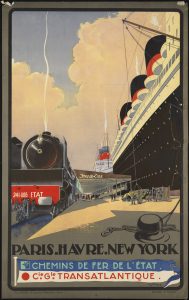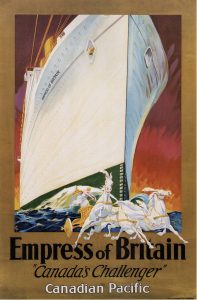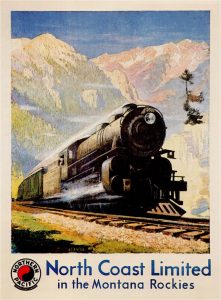 The Golden Age of Travel
The Golden Age of Travel
The years between WWI and WWII are sometimes referred to as the “Golden Age of Travel.” From 1910 through 1959, modern cruise ships, railroads, and commercial airlines made travel both simpler and more economical. Before the 20th century few but the wealthy could afford to travel for pleasure. By the end of the Great War, this was beginning to change. The post war period brought with it growing general economic prosperity. And as Joe Young and Sam M. Davis said in their popular song of 1919, “How Ya Gonna Keep ‘Em Down on the Farm (After They’ve Seen Paree?).”
Travel compan ies like those created by Thomas Cook and Thomas Bennett in the mid-1800’s began to provide travelers with complete travel packages including transportation and lodging. They advertised their services with colorful, eye-catching lithographic posters. Combining large images and bold text, the vintage travel poster was a uniquely effective medium to inspire travelers to see the world, and posters promoting every mode of transportation and destination became fixtures on the kiosks and the train stations of Europe and America.
ies like those created by Thomas Cook and Thomas Bennett in the mid-1800’s began to provide travelers with complete travel packages including transportation and lodging. They advertised their services with colorful, eye-catching lithographic posters. Combining large images and bold text, the vintage travel poster was a uniquely effective medium to inspire travelers to see the world, and posters promoting every mode of transportation and destination became fixtures on the kiosks and the train stations of Europe and America.
Artists from the new schools of design in Europe and the United States borrowed from the modern art movements of Cubism, Futurism, Expressionism, Dada and Constructivism to create arresting images for railroad companies, cruise ship lines and national travel bureaus. The USSR promoted their health resorts and arts festivals. The US Parks Department encouraged Americans to visit our national parks.
The 36 travel posters in this exhibit span the years 1925 through 1960, and include works by Paul Aigner, Leonettto Cappiello, and Dorothy Waugh.
Opening reception and gallery talk
Saturday, January 7 at 1:30 pm
Handforth Gallery, Main Branch

